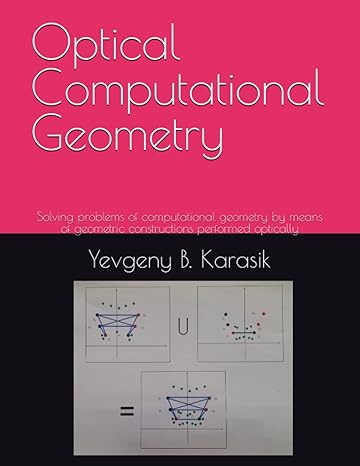Go back


Optical Computational Geometry Solving Problems Of Computational Geometry By Means Of Geometric Constructions Performed Optically(1st Edition)
Authors:
Yevgeny B. Karasik

Cover Type:Hardcover
Condition:Used
In Stock
Include with your book
Free shipping: April 06, 2024Popular items with books
Access to 3 Million+ solutions
Free ✝
Ask 10 Questions from expert
200,000+ Expert answers
✝ 7 days-trial
Total Price:
$0
List Price: $75.00
Savings: $75(100%)
Book details
ISBN: 1687754926, 978-1687754929
Book publisher: Independently published
Get your hands on the best-selling book Optical Computational Geometry Solving Problems Of Computational Geometry By Means Of Geometric Constructions Performed Optically 1st Edition for free. Feed your curiosity and let your imagination soar with the best stories coming out to you without hefty price tags. Browse SolutionInn to discover a treasure trove of fiction and non-fiction books where every page leads the reader to an undiscovered world. Start your literary adventure right away and also enjoy free shipping of these complimentary books to your door.
Optical Computational Geometry Solving Problems Of Computational Geometry By Means Of Geometric Constructions Performed Optically 1st Edition Summary: Geometric problems can be solved in two ways, by calculating the solution or by its construction. The classical means of geometric constructions, the straight edge/ruler and the compass, are very limited in their capabilities. Most geometric problems cannot be solved by constructing the solution with their help. That is why until recently they were solved numerically with the help of algorithms of Computational Geometry. However advances in optical technology allowed solving them through the step-by-step formation of an optical image of the solution. Such image formation is nothing other than its step-by-step construction by optical means. Just not a ruler and a compass are used to draw a solution on a piece of paper, but optical devices are used to step-by-step transform the images of the given figures (represented as optical transparencies) into an image of the solution to a problem. This book is an introduction to the theory of such geometric constructions with the help of optical devices. It presents step-by-step procedures for transforming the light-wave images of given figures into images of solutions to various geometric problems. Such procedures are dubbed optical algorithms in the book. The book is thereby the first presentation of the theory of optical algorithms.
Customers also bought these books
Frequently Bought Together
Top Reviews for Books
Zhongmou Xue
( 5 )
"Delivery was considerably fast, and the book I received was in a good condition."










